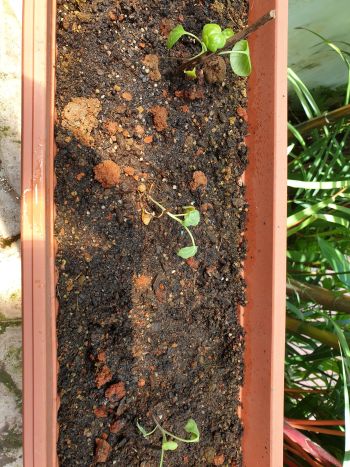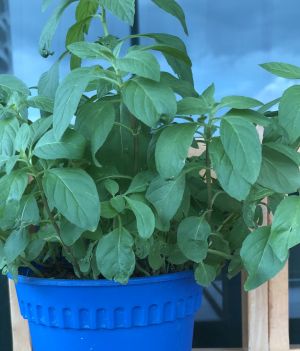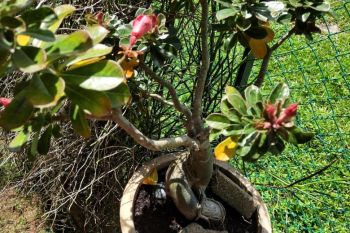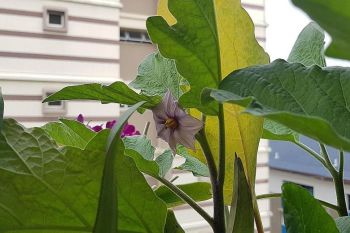Gardening FAQ #28 – What You Need To Know
In this article, we share how to rescue Kailan, what is eggplant, what is transplant shock and much more. Let’s go through the common gardening FAQ, problems and solutions you need when growing your plants either indoor and outdoor.
Kailan may lack fertiliser, sunlight – a common question in gardening FAQ

I have been growing kailan for a month. They do not seem to be growing. What am I not doing right?
The kailan seedlings look yellow – they may be lacking nutrients. If you are growing leafy vegetables from seeds, it is often necessary to apply fertiliser regularly to support the plant’s rapid growth.
In this case, the plants would require a nitrogen-rich fertiliser. Leafy vegetables should be fed weekly with organic fertiliser such as processed chicken manure or bone and blood meal powder.
Ensure your seedlings are protected from rain as excessive rainfall can wash away soluble nitrogen-containing nutrients. Wet feet will also affect nutrient uptake via the roots.
The slower growth of leafy vegetable seedlings could also be due to the lack of sunlight. If you want to grow this better under controlled lighting, you can consider using a grow light. Read up my post on growing lights fixture where I highlight the top 4 things you need to know.
It is important to ensure plants receive at least six hours of direct sunlight daily and that they are not overcrowded.
Plants grown in a crowded environment compete for nutrients, water and sunlight.
Now that you have your kailan growing well. Below is a short video showing two simple ways you can cook the kailan by Jamie.
Ingredients for serving 3 – 4 persons
First way
2 tablespoons of premium oyster sauce
1/2 teaspoon of sugar
1/2 teaspoon of sesame oil
1/2 cup of hot water
180g of kai lan / Chinese broccoli
Some cooking oil
4 cloves of chopped garlic
Second way
Some cooking oil
4 slices of ginger
3 cloves of chopped garlic
1.5 tablespoons of oyster sauce
1/2 tablespoon of fish sauce
1/2 teaspoon of sugar
1/2 cup of water
200g of Chinese broccoli / kai lan
1 tablespoon of Chinese cooking wine (Shaoxing huatiao wine)
Enjoy this today!
Plant is likely a cultivar of the Japanese menthol mint

I have this plant. Is it a peppermint or spearmint?
The mint is neither a spearmint nor a peppermint. It is likely a cultivar of the Japanese menthol mint (Mentha arvensis var piperascens), which is characterised by a high menthol content in its leaves.
It is known locally as “icy mint” due to the sensory response towards the menthol found in the leaves.
Desert rose may be suffering from transplant shock
 The leaves of my five pots of adenium turned yellow within two days of repotting. What happened?
The leaves of my five pots of adenium turned yellow within two days of repotting. What happened?
The yellowing of leaves of your desert rose (Adenium obesum hybrid) may be due to transplant shock.
Leaf scorch is a common symptom of transplant shock. Leaf scorch first appears as a yellowing or bronzing of tissue between the veins or along the margins of leaves of deciduous plants (those that lose their leaves in winter). Later, the discolored tissue dries out and turns brown.
When you repotted your plants, did you remove all the soil from the root ball?
If you did, the process will damage plant roots and this reduces the ability of the plant to uptake water. Leaves turn yellow as a result and may drop off eventually.
A newly transplanted plant should be placed in a slightly shaded and cool area for it to produce new roots. Some growers remove a few leaves from their desert rose plants to reduce the loss of water.
In future, if you want to do such transplant easily, you should explore using grow bags. See my other post on grow bags for more information.
Seed-grown plant is an eggplant
 My seeds have grown. The leaves and stem of the plant are hairy. The plant looks like those bought from markets but without the hair, and the flowers are yellow with seeds. I am not sure if the plant is edible. It looks more like it was cross-bred between the kailan and chye sim.
My seeds have grown. The leaves and stem of the plant are hairy. The plant looks like those bought from markets but without the hair, and the flowers are yellow with seeds. I am not sure if the plant is edible. It looks more like it was cross-bred between the kailan and chye sim.
The plant is an eggplant. Only the fruit of the eggplant should be eaten as the rest of the plant may be toxic.
Eggplants are part of the nightshade family. Nightshades contain alkaloids, including solanine, which can be toxic. Solanine protects these plants while they are still developing.
Eating the leaves or tubers of these plants can lead to symptoms such as burning in the throat, nausea and vomiting, and heart arrhythmias.
Hence, it is important that you only eat the fruit.